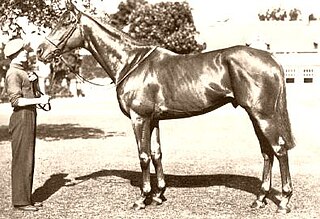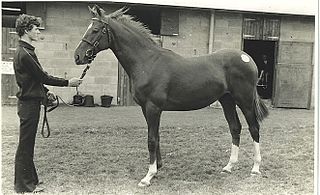
David Lee Freedman is an Australian thoroughbred racehorse trainer. and Hall of Fame inductee. In partnership with brothers Anthony, Michael, and Richard, he has been a prolific winner of Australia's major races in past 20 years, with four Golden Slippers, four Caulfield Cups, two Cox Plates, and five Melbourne Cups, including two of the three won by Makybe Diva. On 19 June 2007 he won the prestigious King's Stand Stakes at the United Kingdom's Royal Ascot racecourse with his champion mare, Miss Andretti.
Ethereal is a New Zealand thoroughbred racehorse. The mare is best known for winning the 2001 Melbourne Cup.

Alycidon (1945–1963) was a British Thoroughbred racehorse who was described as "one of the greatest stayers in history". In a career which lasted from the autumn of 1947 until September 1949 he ran seventeen times and won eleven races. He was the second best British three-year-old of his generation, when he finished second to Black Tarquin in the St. Leger Stakes. He was undefeated in his remaining seven races, defeating Black Tarquin in the 1949 Ascot Gold Cup and going on to win the Stayers' Triple Crown. After his retirement from racing he became the Leading sire in Great Britain & Ireland in 1955, despite having low fertility and a relatively short career at stud.
Levmoss (1965–1977) was an Irish Thoroughbred racehorse whose career lasted from 1967 to 1969. He was the leading stayer in Europe in 1969, when he won the premier long-distance races in England and France. In October of that year he moved down to middle distances to win Europe's most prestigious weight-for-age race, the Prix de l'Arc de Triomphe.
Zarathustra (1951–1967) was an Irish-bred Thoroughbred racehorse and sire. He won races over distances ranging from five furlongs to two and a half miles, but was especially effective over extended distances.
Brown Jack (1924–1948) was a Thoroughbred racehorse that raced over hurdles and then on the flat. He was a "stayer" – a horse specialising in longer races. He won the second Cheltenham Champion Hurdle in 1928, but his main claim to fame was winning the Queen Alexandra Stakes – the longest race in the flat racing calendar – for six years running, from 1929 to 1934. His repeated victories made him one of the most popular racehorses in the history of British racing. A bronze statue of Brown Jack, by the equestrian painter Sir Alfred Munnings, is to be seen at Ascot.
Celeric is a retired, British Thoroughbred racehorse. He improved from running in minor handicaps to Group One level, and recorded his most important win in the 1997 Ascot Gold Cup. In the same year he was named European Champion Stayer at the Cartier Racing Awards. He won thirteen of his forty-two races in a career which lasted from 1994 until his retirement at the age of eight in 2000. Together with Double Trigger, Kayf Tara and Persian Punch he was one of a group of horses credited with revitalising the staying division in the 1990s.

Le Moss was a British Thoroughbred racehorse and sire. A specialist stayer, he excelled at distances of two miles and beyond, winning eleven times from fifteen races between 1977 and 1980. He showed good form as a three-year-old, winning the Queen's Vase and finishing second in the classic St Leger Stakes, but reached his peak as an older horse. In 1979 he completed the "Stayers' Triple Crown" by winning the Ascot Gold Cup, Goodwood Cup and Doncaster Cup. He won the same three races as a five-year-old, defeating the future champion Ardross on each occasion. He was then retired to stud here he had some success as a sire of steeplechasers.
Little Wolf was a British Thoroughbred racehorse and sire. He was best known for his performances in staying races, but was also capable of winning important races over middle distances. Little Wolf was lightly campaigned, running sixteen times between October 1980 and May 1984 and winning seven races. After winning his only race as a two-year-old he won two of his five races including the Scottish Derby and St Simon Stakes in 1981. In the following year he won the Prix Jean de Chaudenay in France before establishing himself as a high-class stayer with an emphatic win in the Jockey Club Cup. In 1983 he won Britain' most prestigious long distance race, the Gold Cup at Royal Ascot and followed up with a record-breaking win in the Goodwood Cup. He was injured in his only subsequent race and was retired to stud where he made no impact as a sire of winners.
Shangamuzo was a British Thoroughbred racehorse and sire best known for winning the Ascot Gold Cup in 1978. A specialist stayer, he won eight of his thirty-four races, finished second nine times and third on five occasions.
Anzum was a British Thoroughbred racehorse best known for his performances in National Hunt racing. After failing to win in eight races on the flat he made an immediate impact when switched to hurdle races, winning his first six races over obstacles including the Summit Junior Hurdle and taking third place in the Triumph Hurdle. After winning only once in the next three years he established himself as a leading staying hurdler in 1999 with wins in the Stayers' Hurdle, Champion Stayers Hurdle and Long Walk Hurdle. He ran his last race in April 2001 and was retired with a record of ten wins and fourteen places from thirty-two starts.
Nomadic Way was an American-bred, British-trained Thoroughbred racehorse and sire. He was a successful stayer on the flat and was a top class hurdler under National Hunt rules, switching between the two codes in a racing career which lasted from October 1987 until January 1993.
Tehran (1941–1966) was a British Thoroughbred racehorse and sire, who raced during World War II and was best known for winning the classic St Leger in 1944. After showing little ability as a two-year-old he improved in the following spring to win the Culford Stakes on his three-year-old debut. He ran third in the 2000 Guineas and was narrowly beaten into second place in the Derby Stakes. After winning the Whepstead Stakes he recorded his biggest win when defeating a strong field in a substitute St Leger. He won his first three races in 1945 and finished second in the Ascot Gold Cup. He later became a successful breeding stallion, siring several major winners including Tulyar.
Felicitation was a British Thoroughbred racehorse and sire. A specialist stayer, owned and bred by the Aga Khan he was best known for his emphatic victory over a very strong international field in the 1934 Ascot Gold Cup. He was one of the best two-year-olds of his generation in England in 1932 when he was awarded the Middle Park Stakes on the disqualification of Manitoba. He failed to win in eight starts as a three-year-old but ran well to finish second in to Hyperion in the St Leger. In the summer of 1934 he established himself as one of the best horses in Europe by winning the Ascot Gold Cup, John Porter Stakes and Jockey Club Cup as well as finishing third in the Prix de l'Arc de Triomphe. He was injured when winning the Yorkshire Cup as a five-year-old and was retired from racing. He stood as a breeding stallion in England and Brazil with moderate results.
Easton was a French-bred, Thoroughbred racehorse and sire. After winning two minor races in France he made an immediate impact on his British debut when finishing second to Colombo in the 2000 Guineas. He was then bought by Lord Woolavington and transferred permanently to England. He finished second to Windsor Lad in a very strong renewal of The Derby and third in the Grand Prix de Paris before winning the Grand International d'Ostend in Belgium and the Select Stakes at Newmarket. In the following year he won highly-competitive races at Lingfield and Newmarket before being beaten in a rematch with Windsor Lad for the Coronation Cup. He was retired from racing after winning the Ribblesdale Stakes at Royal Ascot. He made little impact as a breeding stallion in Europe but sired some good winners in the United States.
Roman Hackle was a British Thoroughbred racehorse who won the 1940 Cheltenham Gold Cup. After winning several races over hurdles he was switched to steeplechasing in 1939 and made an immediate impact by winning the Broadway Novices' Chase. In the following year he won the Gold Cup as a seven-year-old but did not build on his early promise. In two subsequent bids for the Gold Cup he ran poorly when favourite in 1941 and fell in 1942. His British career ended when National Hunt racing in Britain was suspended in September 1942 but he went on to win races in Ireland.
Salmon-Trout was a British Thoroughbred racehorse and sire. He showed very promising form as a two-year-old in 1923 when he won both of his races,namely the Prendergast Stakes and Dewhurst Stakes. In the following year he won four of his ten races including the Princess of Wales's Stakes and the St Leger as well as being placed in the Newmarket Stakes and the Champion Stakes. In 1925 he finished second in the Ascot Gold Cup. After his retirement from racing he stood as a breeding stallion in England and South Africa and had some success as a sire of winners.
Flamingo was a British Thoroughbred racehorse and sire. In 1927 he was one of the best two-year-old colts in England when he won three of his five races including the National Breeders' Produce Stakes. In the following year he won the 2000 Guineas and the Great Yorkshire Stakes as well as finishing second in the Epsom Derby and fourth in the St Leger. After his retirement from racing he had some success as a breeding stallion.
Petronel was a British Thoroughbred racehorse and sire. After showing promise when winning the Troy Stakes as a juvenile in 1879 he recorded a major upset when defeating his more fancied opponents to take the 2000 Guineas in the following spring. He had never been entered in the other British Classic Races but won at Royal Ascot and in several other top-class races that year. In 1881 he was one of the best staying horses in England, winning seven races including the Epsom Stakes, Rous Memorial Stakes, Great Yorkshire Handicap and Doncaster Cup as well as Queen's Plates at Stockbridge, Newmaket and Liverpool. He developed breathing problems and was never as good again although he won Queen's Plates at Stockbridge and Newcastle in 1882. After his retirement from racing he had some success as a breeding stallion.

Stradivarius is an Irish-bred British-trained Thoroughbred racehorse. After winning one minor race as a two year old he emerged as a top-class stayer in the following year, winning the Queen's Vase and Goodwood Cup as well as finishing a close third in the St Leger. As a four-year-old he won the Yorkshire Cup, Ascot Gold Cup, a second Goodwood Cup and the Lonsdale Cup, securing a £1 million bonus for winning all four races, and ended the year by winning the British Champions Long Distance Cup.







